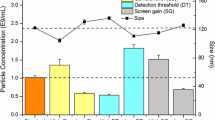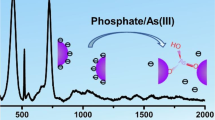Abstract
With the development of nanosciences, both localized surface plasmon resonance light scattering (LSPR-LS) and dynamic light scattering (DLS) techniques have been widely used for quantitative purposes with high sensitivity. In this contribution, we make a comparison of the two light scattering techniques by employing gold nanoparticles (AuNPs) aggregation induced by mercuric ions. It was found that citrate-stabilized AuNPs got aggregated in aqueous medium in the presence of mercuric ions through a chelation process, resulting in greatly enhanced LSPR-LS signals and increased hydrodynamic diameter. The enhanced LSPR-LS intensity (ΔI) is proportional to the concentration of mercuric ions in the range of 0.4–2.5 μM following the linear regression equation of ΔI = −84.7+516.4c, with the correlation coefficient of 0.983 (n = 6) and the limit of determination (3σ) about 0.10 μM. On the other hand, the increased hydrodynamic diameter can be identified by the DLS signals only with a concentration of Hg2+ in the range of 1.0–2.5 μM, and a linear relationship between the average hydrodynamic diameters of the resulted aggregates and the concentration of Hg2+ can be expressed as d = −6.16 + 45.9c with the correlation coefficient of 0.994. In such case, LSPR-LS signals were further applied to the selective determination of mercuric ions in lake water samples with high sensitivity and simple operation.
Similar content being viewed by others
References
Willets KA, Duyne RPV. Localized surface plasmon resonance spectroscopy and sensing. Annu Rev Phys Chem, 2007, 58: 267–297
Yguerabide J, Yguerabide EE. Light-scattering submicroscopic particles as highly fluorescent analogs and their use as tracer labels in clinical and biological applications I. Theory. Anal Biochem, 1998, 262: 137–156
Du BA, Li ZP, Liu CH. One-step homogeneous detection of DNA hybridization with gold nanoparticle probes by using a linear light-scattering technique. Angew Chem Int Ed, 2006, 45: 8022–8025
Li ZP, Duan XR, Liu CH, Du BA. Selective determination of cysteine by resonance light scattering technique based on self-assembly of gold nanoparticles. Anal Biochem, 2006, 351: 18–25
Fan Y, Long YF, Li YF. A sensitive resonance light scattering spectrometry of trace Hg2+ with sulfur ion modified gold nanoparticles. Anal Chim Acta, 2009, 653: 207–211
Du BA, Li ZP, Cheng YQ. Homogeneous immunoassay based on aggregation of antibody-functionalized gold nanoparticles coupled with light scattering detection. Talanta, 2008, 75: 959–964
Bloomfield VA. Static and dynamic light scattering from aggregating particles. Biopolymers, 2000, 54: 168–172
Kadima W, McPherson A, Dunn MF, Jurnak FA. Characterization of precrystallization aggregation of canavalin by dynamic light scattering. Biophys J, 1990, 57: 125–132
Lee WI, Schurr JM. Dynamic light scattering studies of poly-L-lysine HBr in the presence of added salt. Biopolymers, 2004, 13: 903–908
Moradian-Oldak J, Leung W, Fincham AG. Temperature and pH-dependent supramolecular self-assembly of amelogenin molecules: A dynamic light-scattering analysis. J Struct Biol, 1998, 122: 320–327
Gallagher WH, Woodward CK. The concentration dependence of the diffusion coefficient for bovine pancreatic trypsin inhibitor: A dynamic light scattering study of a small protein. Biopolymers, 2004, 28: 2001–2024
Jans H, Liu X, Austin L, Maes G, Huo Q. Dynamic light scattering as a powerful tool for gold nanoparticle bioconjugation and biomolecular binding studies. Anal Chem, 2009, 81: 9425–9432
Kalluri JR, Arbneshi T, Afrin Khan S, Neely A, Candice P, Varisli B, Washington M, McAfee S, Robinson B, Banerjee S, Singh AK, Senapati D, Ray PC. Use of gold nanoparticles in a simple colorimetric and ultrasensitive dynamic light scattering assay: Selective detection of arsenic in groundwater. Angew Chem Int Ed, 2009, 121: 9848–9851
Dai Q, Liu X, Coutts J, Austin L, Huo Q, A one-step highly sensitive Ray PC. Gold nanoparticle-based miniaturized nanomaterial surface energy transfer probe for rapid and ultrasensitive detection of mercury in soil, water, and fish. ACS Nano, 2007, 1: 208–214
Huang CC, Huang YF, Cao ZH, Tan WH, Chang HT. Aptamer-modified gold nanoparticles for colorimetric determination of platelet-derived growth factors and their receptors. Anal Chem, 2005, 77: 5735–5741
Kim Y, Johnson RC, Hupp JT. Gold nanoparticle-based sensing of “spectroscopically silent” heavy metal ions. Nano Lett, 2001, 1: 165–167
Long YF, Huang CZ, Li YF. Hybridization detection of DNA by measuring organic small molecule amplified resonance light scattering signals. J Phys Chem B, 2007, 111: 4535–4538
Zhao HW, Huang CZ, Li YF. Immunoassay by detecting enhanced resonance light scattering signals of immunocomplex using a common spectrofluorometer. Talanta, 2006, 70: 609–614
Pecora R. Dynamic light scattering measurement of nanometer particles in liquids. J Nanoparticle Res, 2000, 2: 123–131
Author information
Authors and Affiliations
Corresponding author
Rights and permissions
About this article
Cite this article
Wang, W., Liu, C., Ling, J. et al. Mercuric ions induced aggregation of gold nanoparticles as investigated by localized surface plasmon resonance light scattering and dynamic light scattering techniques. Sci. China Chem. 56, 806–812 (2013). https://doi.org/10.1007/s11426-012-4819-z
Received:
Accepted:
Published:
Issue Date:
DOI: https://doi.org/10.1007/s11426-012-4819-z




